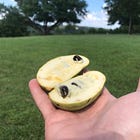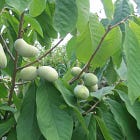Thriving in the Shade: The Remarkable Growth of Pawpaws in Understory Environments
The Art of Cultivating Pawpaws in Forest Understories and Shaded Gardens
The pawpaw, a lesser-known yet fascinating fruit tree, thrives in a unique niche within horticulture. Known scientifically as Asimina triloba, the pawpaw tree boasts a rare quality in fruit-bearing trees: its ability to prosper in partial shade. This characteristic makes it an ideal candidate for understory planting, flourishing beneath the canopy of larger trees or in areas with filtered sunlight. This article explores the growth of pawpaws in such environments, highlighting their unique adaptations and the benefits they bring to gardeners and ecosystems alike.
Understanding the Pawpaw Tree
The pawpaw (Asimina triloba) is a deciduous tree or shrub, part of the custard apple family (Annonaceae), and is notable for producing the largest tree-borne fruit native to North America. This tree is native to the United States, stretching from the Atlantic coast north to New York and west to Michigan and Kansas. The pawpaw can grow up to 12 meters (40 feet) tall and has pointed, broadly oblong, drooping leaves up to 30 cm (12 inches) long. It produces malodorous, purple flowers in spring, which precede the leaves. The edible fruits, which resemble stubby bananas, are 8 to 18 cm (3 to 7 inches) long with a skin that turns black upon ripening. The golden, custard-like flesh of the fruit can vary in size, ripening time, and flavor, often reminiscent of bananas and mangoes.12
The pawpaw has deep roots in the cultural history of Native American tribes, especially the Shawnee, for whom it symbolizes a tangible connection to their ancestral lands in Appalachia. The Shawnee designated September as “ha’siminikiisfwa” or Pawpaw month, the time when pawpaws were ripe for harvest. Despite being forced from their Ohio Valley home due to the Indian Removal Act of 1830, their connection to the pawpaw tree has persisted in their memory and language. Some tribal members continue to plant pawpaw trees in their yards to maintain this cultural link. The pawpaw also plays a significant role in modern efforts to recover and preserve indigenous food knowledge, with scholars like Dr. Devon Mihesuah of the Choctaw Nation advocating for the reintroduction of indigenous foods like the pawpaw into modern diets, viewing it as a way to heal historical trauma.
In addition, the pawpaw was utilized by indigenous communities in various ways. The Ojibwe First Nations, for instance, used the bark of the pawpaw tree to weave ropes, nets, and mats for stringing fish. The fruit was also considered to have medicinal properties and is currently being studied for potential cancer-fighting capabilities. Following the arrival of European settlers, the native inhabitants introduced them to the pawpaw, and it subsequently became a part of American folklore, as reflected in the traditional song “Way Down Yonder in the Pawpaw Patch”34.
The Significance of Understory Growth
The understory in forestry and ecology refers to the layer of vegetation that grows beneath the forest canopy without significantly penetrating it, but above the forest floor. This layer typically consists of shade-tolerant plants, including stunted trees, small trees with low light requirements, saplings, shrubs, vines, and undergrowth. For example, trees like holly and dogwood are understory specialists. In tropical forests, the canopy can intercept around 95% of sunlight, leaving the understory with less intense and wavelength-impoverished light. Understory plants have adapted to be shade-tolerant, able to photosynthesize adequately with the available light, often using wavelengths that canopy plants cannot. This adaptation is crucial for maintaining a net positive carbon balance over the year, especially in temperate deciduous forests where understory plants can photosynthesize before the canopy trees leaf out5.
Pawpaw trees, native to the humid eastern United States, are well-suited to understory environments. They have large, light to medium green, palm-like leaves which provide significant shade cover, aiding in their adaptation to low-light environments. The leaves, branches, and bark of pawpaw trees emit a slightly disagreeable odor due to acetogenins, which act as a natural insecticide to protect the tree. These trees can tolerate sun or shade, but young pawpaw trees require some shade until they are established, typically for 1 to 2 years or until they reach about 18 inches in height. Mature pawpaw trees are hardy and relatively pest-free, and their shade tolerance makes them suitable for intercropping with other trees, such as the black locust (Robinia pseudoacacia), which casts sparse, dappled shade. However, fruiting in pawpaw trees is compromised in full, dense shade, making it essential for growers to balance the amount of shade the trees receive67.
Benefits of Growing Pawpaws in Partial Shade
Pawpaws naturally thrive in understory environments, where they have adapted to prosper with limited sunlight. They grow best in areas with filtered sunlight, such as under the canopy of a larger tree. This adaptation is key in settings with partial shade, where pawpaws face less competition for sunlight compared to full-sun environments. This allows them to efficiently utilize the available light, fostering healthy growth without the stress of competing with larger, sun-loving plants. Moreover, the partial shade aids in maintaining soil moisture, a boon for pawpaws that prefer not to be in overly dry conditions. The cooler, moister soil in these shaded areas reduces the rate of evaporation, ensuring consistent moisture availability, a critical factor for pawpaw trees.
Mature pawpaw trees can tolerate sun or shade, but young trees need some shade until they are established (1 to 2 years or 18 inches tall). Mature trees need full sun if you want them to produce as much fruit as possible. However, they will tolerate partial shade. Young pawpaw trees are sensitive to intense sunlight, according to the North Carolina State University Extension.
In terms of pest and disease resistance, pawpaws are known to be free of serious pests and diseases. However, they are susceptible to a few pests and diseases, including black spot and powdery mildew. Regular monitoring and treatment can help prevent these issues. The shaded, cooler environment provided by partial shade can help reduce certain pest and disease pressures, although specific details on how the shaded environment impacts pest and disease resistance in pawpaws were not found in the available sources89.
Planting and Caring for Pawpaws in Shaded Areas
When planting pawpaws, selecting the right location is critical for their growth. Pawpaws flourish in partially shaded areas, typically under the canopy of larger trees. This mimics their natural understory habitat in the wild. The ideal site should provide filtered sunlight, protecting young pawpaw trees from intense direct sunlight, which they are sensitive to in their early stages of growth. Mature pawpaw trees, however, can handle more sunlight and will produce more fruit in sunnier spots, although they still tolerate partial shade. The site should also allow for good air circulation to promote healthy growth and reduce the risk of diseases.
Soil and Water Requirements
Pawpaws prefer well-drained, fertile soil, rich in organic matter. They can tolerate temporarily moist soil, often found in their natural floodplain habitats, but prolonged waterlogging can be detrimental. The soil pH suitable for pawpaws ranges from slightly acidic to neutral. In terms of water requirements, pawpaws need consistent moisture, especially in the initial growth stages. The partially shaded conditions help maintain soil moisture, reducing the need for frequent watering. However, it's important to ensure that the soil does not remain overly wet, as this can lead to root rot.
Pruning and Maintenance in an Understory Setting
Pruning pawpaws in an understory setting involves removing dead or overcrowded branches to enhance air circulation and light penetration, which is crucial for the health of the tree. Regular pruning also helps in maintaining the desired shape and size of the tree, especially in a confined space. It's important to prune pawpaws during their dormant season to minimize stress on the tree.
Maintenance of pawpaws in partial shade includes regular monitoring for pests and diseases, although they are generally free from serious issues. Young trees are more susceptible to problems like black spot and powdery mildew, so it's crucial to keep an eye on them and treat any issues promptly. Mulching around the base of the tree can help retain soil moisture and regulate temperature, further promoting healthy growth1011.
Ecological and Landscape Benefits
Pawpaw trees contribute significantly to local biodiversity. With their broad, umbrella-like leaves and unique fruit, pawpaws provide habitat and nourishment for various insects and birds, enhancing garden biodiversity. In their native regions, they're closely associated with the Zebra Swallowtail butterfly, whose larvae feed exclusively on pawpaw leaves. This interaction highlights the pawpaw's role in supporting specific wildlife species. Although this butterfly-pawpaw relationship may be location-dependent, in areas where the pawpaw isn't native, it still contributes to local ecosystems. Its flowers offer nectar to diverse insects, while its fruit is a food source for many bird species, making it a valuable addition to any garden or permaculture design.
Pawpaws also offer significant aesthetic benefits in garden design, especially in shaded areas. They are known for their stunning year-round appearance. In spring, pawpaws produce dramatic dark blossoms, reminiscent of gothic sculptures, which transform into North America's largest edible fruit by fall. Their unique crimson blooms in early spring attract pollinators and deter deer and other herbivores. During summer, their lush green canopy provides shade, and in fall, they exhibit a spectacular color show with their leaves turning bright yellow. The fruit peaks in September and October, adding to the visual appeal. The attractive foliage, spring blossoms, and the overall tropical appearance of pawpaws add aesthetic value to landscapes, making them an excellent choice for gardeners looking to enhance the visual interest of their shaded areas 12131415.
Final Words on Shaded Pawpaw Trees
The pawpaw tree, with its unique ability to thrive in partial shade, presents an opportunity for gardeners and ecologists alike. By understanding and harnessing this capability, we can integrate these remarkable trees into our landscapes, enhancing biodiversity and enjoying their delicious fruits. The understory growth of pawpaws serves as a testament to the adaptability and resilience of nature, offering a model for sustainable gardening and ecological preservation.
Learn More About Pawpaw Trees
Asimina triloba - Wikipedia
Plant Profile: Pawpaw – The Forgotten Fruit of America's Heartland - Hugelkultur Works.
The Power of the Pawpaw Tree: Bridging the Past to the Future - Orchard People
Understory - Wikipedia
What Is A Pawpaw Tree? (5 Key Things To Know) - Green Upside
Pawpaw – A "Tropical" Fruit for Temperate Climates - Cornell Small Farms
What Is A Pawpaw Tree? (5 Key Things To Know) – Green Upside
ENH245/ST086: Asimina triloba: Pawpaw - University of Florida IFAS Extension
What Is A Pawpaw Tree? (5 Key Things To Know) - Green Upside
ENH245/ST086: Asimina triloba: Pawpaw - University of Florida IFAS Extension
Pawpaw in Permaculture: How to Incorporate Pawpaw into Your Food Forest - Hugelkultur Works
7 Compelling Reasons to Grow Pawpaw Trees in Pennsylvania - Gold Hat Nursery
"The North American Pawpaw" - Barefoot Garden Design
Growing Native Pawpaw Trees: A Guide to Planting - The Plant Native








